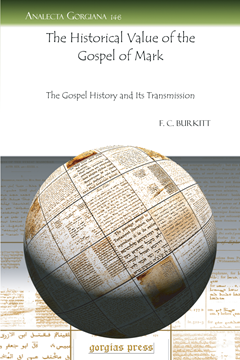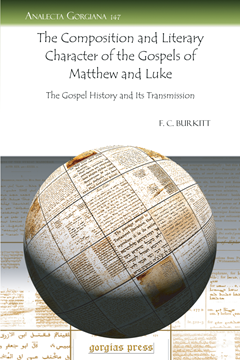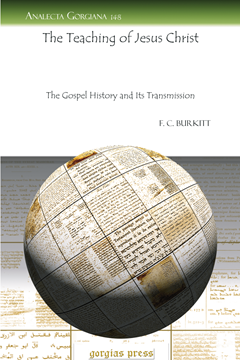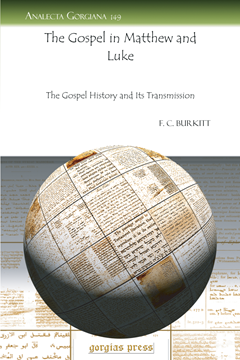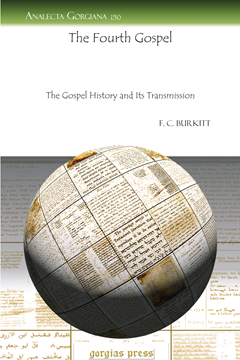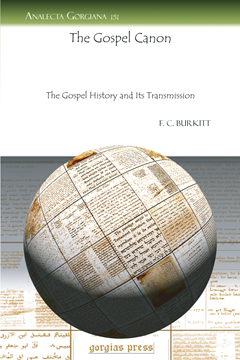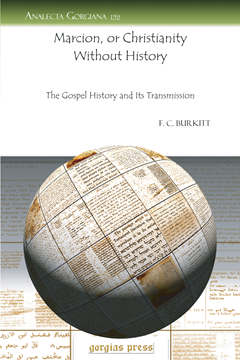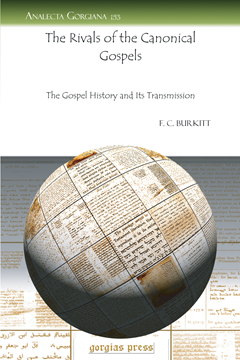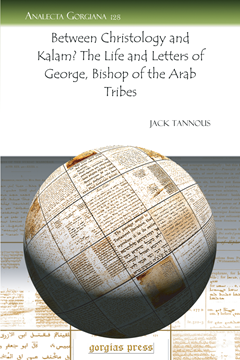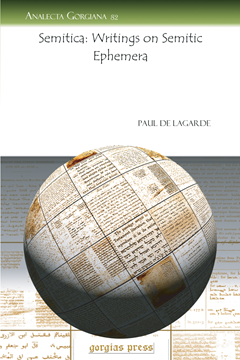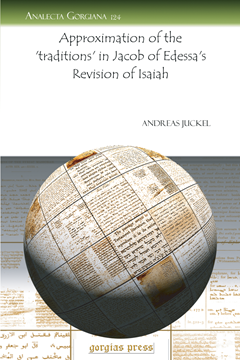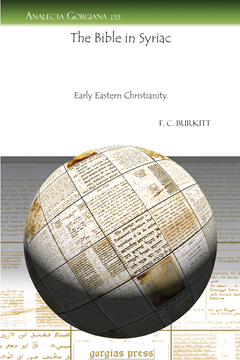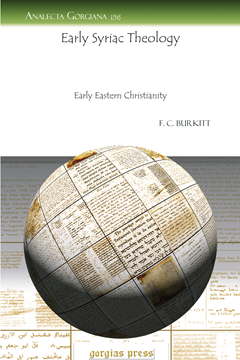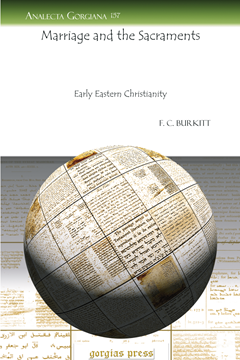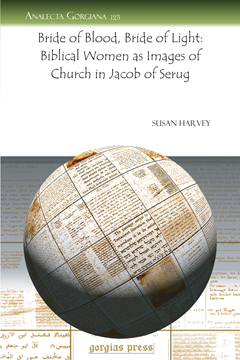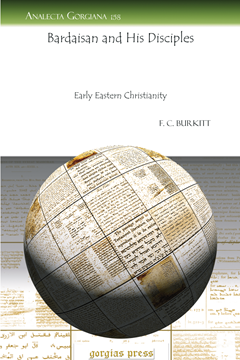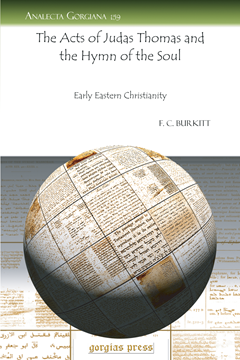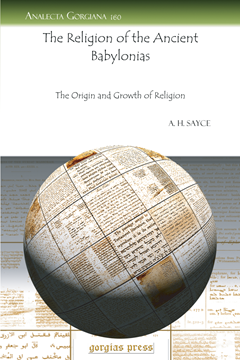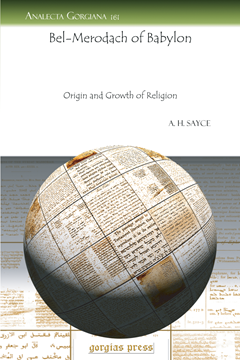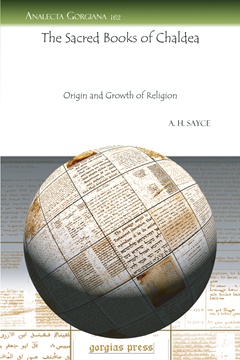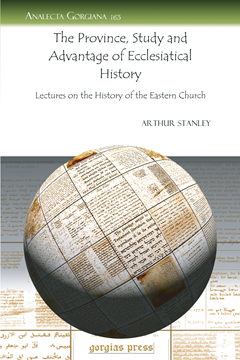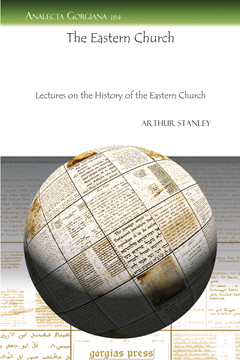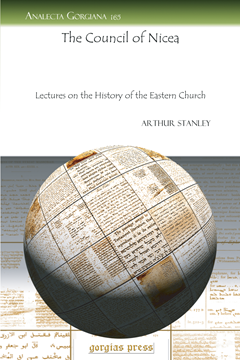Analecta Gorgiana
Analecta Gorgiana is a collection of long essays and short monographs which are consistently cited by modern scholars but previously difficult to find because of their original appearance in obscure publications. Carefully selected by a team of scholars based on their relevance to modern scholarship, these essays can now be fully utilized by scholars and proudly owned by libraries.
The Literary Originality of the Gospel of Mark
The Gospel History and Its Transmission
Series: Analecta Gorgiana 145
ISBN: 978-1-60724-114-0
Originally delivered as one of the Jowett Lectures for 1906, the contents of this booklet emerged during the first quest for the historical Jesus. Somewhat surprisingly, Burkitt discovered that historical criticism increased the historical credibility of the Synoptic Gospels in his estimation. This first lecture in the series addresses the literary originality of the Gospel of Mark. Here Burkitt surveys the priority of Mark, the shared Synoptic material, and the literarily unique sections of Mark.
$36.00 (USD) $21.60 (USD)
The Historical Value of the Gospel of Mark
The Gospel History and Its Transmission
Series: Analecta Gorgiana 146
ISBN: 978-1-60724-115-7
Originally delivered as one of the Jowett Lectures for 1906, the contents of this booklet emerged during the first quest for the historical Jesus. Somewhat surprisingly, Burkitt discovered that historical criticism increased the historical credibility of the Synoptic Gospels in his estimation. This second lecture in the series addresses the historical value of the Gospel of Mark. Here Burkitt considers the historical questions of how accurately Mark may portray his limited life of Jesus.
$39.00 (USD) $23.40 (USD)
The Composition and Literary Character of the Gospels of Matthew and Luke
The Gospel History and Its Transmission
Series: Analecta Gorgiana 147
ISBN: 978-1-60724-116-4
Originally delivered as one of the Jowett Lectures for 1906, the contents of this booklet emerged during the first quest for the historical Jesus. Somewhat surprisingly, Burkitt discovered that historical criticism increased the historical credibility of the Synoptic Gospels in his estimation. This third lecture in the series addresses the composition and literary characteristics of the Gospels of Matthew and Luke.
$38.00 (USD) $22.80 (USD)
The Teaching of Jesus Christ
The Gospel History and Its Transmission
Series: Analecta Gorgiana 148
ISBN: 978-1-60724-117-1
Originally delivered as one of the Jowett Lectures for 1906, the contents of this booklet emerged during the first quest for the historical Jesus. Somewhat surprisingly, Burkitt discovered that historical criticism increased the historical credibility of the Synoptic Gospels in his estimation. This fourth lecture in the series begins by noting that in early Christianity it was Jesus that was preached and not Jesus’ sayings. Burkitt thus suggests some criteria for finding Jesus’ original words and then applies them in order to reconstruct the teachings of Jesus.
$41.00 (USD) $24.60 (USD)
The Gospel in Matthew and Luke
The Gospel History and Its Transmission
Series: Analecta Gorgiana 149
ISBN: 978-1-60724-118-8
Originally delivered as one of the Jowett Lectures for 1906, the contents of this booklet emerged during the first quest for the historical Jesus. Somewhat surprisingly, Burkitt discovered that historical criticism increased the historical credibility of the Synoptic Gospels in his estimation. This fifth lecture in the series examines the concept of gospel in Matthew and Luke. Burkitt notes the special emphases and concerns of these two Gospel writers, calling attention to how they differ from each other and also from Mark.
$38.00 (USD) $22.80 (USD)
The Fourth Gospel
The Gospel History and Its Transmission
Series: Analecta Gorgiana 150
ISBN: 978-1-60724-119-5
Originally delivered as one of the Jowett Lectures for 1906, the contents of this booklet emerged during the first quest for the historical Jesus. Somewhat surprisingly, Burkitt discovered that historical criticism increased the historical credibility of the Synoptic Gospels in his estimation. This sixth lecture in the series turns to the Gospel of John. Burkitt addresses the enduring questions of authorship and historicity, comparing the Gospel of John to the Synoptics, Philo, the Gnostics, and the Stoics.
$41.00 (USD) $24.60 (USD)
The Gospel Canon
The Gospel History and Its Transmission
Series: Analecta Gorgiana 151
ISBN: 978-1-60724-120-1
Originally delivered as one of the Jowett Lectures for 1906, the contents of this booklet emerged during the first quest for the historical Jesus. Somewhat surprisingly, Burkitt discovered that historical criticism increased the historical credibility of the Synoptic Gospels in his estimation. This seventh lecture in the series traces the origin of the authoritative four-fold Gospels to about 150 of the Common Era when they are amply attested together. Positing a three-stage evolution to the canonical Gospels, Burkitt notes that other Gospels did not measure up to the same standard.
$38.00 (USD) $22.80 (USD)
Marcion, or Christianity Without History
The Gospel History and Its Transmission
Series: Analecta Gorgiana 152
ISBN: 978-1-60724-121-8
Originally delivered as one of the Jowett Lectures for 1906, the contents of this booklet emerged during the first quest for the historical Jesus. Somewhat surprisingly, Burkitt discovered that historical criticism increased the historical credibility of the Synoptic Gospels in his estimation. This eighth lecture in the series addresses Marcion. Burkitt focuses on how this early Christian thinker remained ahead of his time while also falling out of the mainstream of what was an emerging Christianity.
$39.00 (USD) $23.40 (USD)
The Rivals of the Canonical Gospels
The Gospel History and Its Transmission
Series: Analecta Gorgiana 153
ISBN: 978-1-60724-122-5
Originally delivered as one of the Jowett Lectures for 1906, the contents of this booklet emerged during the first quest for the historical Jesus. Somewhat surprisingly, Burkitt discovered that historical criticism increased the historical credibility of the Synoptic Gospels in his estimation. This ninth lecture in the series concerns itself with the non-canonical, or apocryphal gospels. Written before the discovery of the Nag-Hammadi library, this study considers the Testamentum Domini, Pistis Sophia, the Gospel and Apocalypse of St. Peter, the Protevangelium of James, the Infancy Gospel of Thomas, the Gospel According to the Hebrews, and the Oxyrhynchus Logia..
$37.00 (USD) $22.20 (USD)
Between Christology and Kalām? The Life and Letters of George, Bishop of the Arab Tribes
By Jack Tannous
Series: Analecta Gorgiana 128
ISBN: 978-1-60724-040-2
A translator of Aristotle and friend of Jacob of Edessa and Athanasios of Balad, George, Bishop of the Arab Tribes (d. AD 724) was an important figure in the history of the life and thought of the Syrian Orthodox Church. This article offers a study of the first three of George’s eleven extant letters and relates them to the larger Christian and Islamic context of his day. It will be of interest to students of Greek patristics, Syriac Christianity, and early Islamic history.
$41.00 (USD) $24.60 (USD)
Writings on Semitic Ephemera
Series: Analecta Gorgiana 82
ISBN: 978-1-59333-894-7
Originally published in two small volumes of Semitic ephemera written in German, this collection of observations of Paul de Lagarde still contains his cogent insights into the world of Semitic linguistics. Critical remarks on the book of Isaiah introduce his characteristic detail on a number of verses in the prophetic book. The second selection concerns the clarification of Akkadian (Chaldean) words occurring in the Hebrew Bible. In the second major section of the work, de Lagarde presents the leaves of the Septuagint of Codex Sarravianus found in Paris. This annotated Greek material comes from the books of Exodus, Leviticus, and Numbers.
$59.00 (USD) $35.40 (USD)
Approximation of the ‘traditions’ in Jacob of Edessa’s Revision of Isaiah
Series: Analecta Gorgiana 124
ISBN: 978-1-60724-036-5
This article contributes to the knowledge of Jacob of Edessa’s (d. 708) Old Testament revision by editing twenty texts (a total of 80 verses) from the Book of Isaiah and comparing them with the Greek recensions of the Septuagint, with the Peshitta, and the Syrohexapla. Two special features are introduced to set out Jacob’s revision technique in some detail: 1. comparison with an earlier undeveloped stage of Jacob’s revision extant in Ms Add 17,134 of the British Library; and 2. the distinction (by different colours and fonts) of the ‘traditions’ involved in the definite stage of his revision. Both features point to the emphasis given to the Peshitta in translating the substantial Greek text of the Old Testament.
$43.00 (USD) $25.80 (USD)
The Early Bishops of Edessa
Early Eastern Christianity
Series: Analecta Gorgiana 154
ISBN: 978-1-60724-123-2
Originally delivered as one of the St. Margaret’s Lectures for 1904, the contents of this booklet are focused on aspects of the Syriac-speaking Church. Extracted from Burkitt’s book Early Eastern Christianity, the first lecture concerns the early bishops of Edessa. Starting from the basic difference between Eastern and Western Christian outlooks, Burkitt briefly sketches the early history of documented Edessa. Christianity appeared in the city between its sacking by the Romans and its incorporation into the Roman Empire around the start of the third century A.D.
$32.80 (USD) $19.68 (USD)
The Bible in Syriac
Early Eastern Christianity
Series: Analecta Gorgiana 155
ISBN: 978-1-60724-125-6
Originally delivered as one of the St. Margaret’s Lectures for 1904, the contents of this booklet are focused on aspects of the Syriac-speaking Church. Extracted from Burkitt’s book Early Eastern Christianity, the second lecture proposes a theory of how the Syriac Bible was compiled. Burkitt considers the role of the Peshitta, the Diatessaron, and the four Gospels and how their history at Edessa suggests that the Syriac Bible appeared.
$41.00 (USD) $24.60 (USD)
Early Syriac Theology
Early Eastern Christianity
Series: Analecta Gorgiana 156
ISBN: 978-1-60724-126-3
Originally delivered as one of the St. Margaret’s Lectures for 1904, the contents of this booklet are focused on aspects of the Syriac-speaking Church. Extracted from Burkitt’s book Early Eastern Christianity, the third lecture concerns the theology of Eastern Christianity. Burkitt provides a brief survey of the work of Aphraates, Philoxenus of Mabbug, Ephraim the Syrian, and Rabbula.
$41.00 (USD) $24.60 (USD)
Marriage and the Sacraments
Early Eastern Christianity
Series: Analecta Gorgiana 157
ISBN: 978-1-60724-129-4
Originally delivered as one of the St. Margaret’s Lectures for 1904, the contents of this booklet are focused on aspects of the Syriac-speaking Church. Extracted from Burkitt’s book Early Eastern Christianity, the fourth lecture concerns the development of marriage and the role of sacraments in the early Syriac Church. Burkitt finds that marriage was not early regarded as a sacrament and the married faithful were not permitted the sacraments of baptism or communion in the early tradition represented by Aphraates.
$39.00 (USD) $23.40 (USD)
Biblical Women as Images of Church in Jacob of Serug
Series: Analecta Gorgiana 123
ISBN: 978-1-60724-050-1
This study seeks to address the common bridal imagery pervasive in ancient Syriac Christianity by asking how Jacob of Serug employed the presentation of biblical women in his homilies to serve as imagery for the Church.
$37.00 (USD) $22.20 (USD)
Bardaisan and His Disciples
Early Eastern Christianity
Series: Analecta Gorgiana 158
ISBN: 978-1-60724-130-0
Originally delivered as one of the St. Margaret’s Lectures for 1904, the contents of this booklet are focused on aspects of the Syriac-speaking Church. Extracted from Burkitt’s book Early Eastern Christianity, the fifth lecture explores Bardaisan and his unique contribution to Syriac Christianity.
$41.00 (USD) $24.60 (USD)
The Acts of Judas Thomas and the Hymn of the Soul
Early Eastern Christianity
Series: Analecta Gorgiana 159
ISBN: 978-1-60724-136-2
Originally delivered as one of the St. Margaret’s Lectures for 1904, the contents of this booklet are focused on aspects of the Syriac-speaking Church. Extracted from Burkitt’s book Early Eastern Christianity, the sixth lecture examines the ancient Syriac novel, The Acts of Judas Thomas. Embedded within that story is a Gnostic Hymn of the Soul, to which Burkitt pays special regard.
$39.00 (USD) $23.40 (USD)
The Religion of the Ancient Babylonias
The Origin and Growth of Religion
By A. H. Sayce
Series: Analecta Gorgiana 160
ISBN: 978-1-60724-175-1
As the introductory lecture to his collection of observations on ancient religion, Sayce begins this extract with a consideration of the difficulties of knowing what can be deduced from ancient Mesopotamian religion. Extracted from Sayce’s Origin and Growth of Religion, this booklet will be of interest to those who research the early period of the field of Assyriology in order to learn where various concepts about Mesopotamian religious life have their genesis.
$50.00 (USD) $30.00 (USD)
Bel-Merodach of Babylon
Origin and Growth of Religion
By A. H. Sayce
Series: Analecta Gorgiana 161
ISBN: 978-1-60724-176-8
In this second lecture extracted from Sayce’s Origin and Growth of Religion, the renowned Assyriologist specifically considers the Babylonian deity Bel-Merodach. Noting that Cyrus the Great was a worshipper of this deity, the outlook of the priesthood of Bel-Merodach regarding his conquest of Babylon begins the discussion. Sayce then discusses localized versions of Merodach, considering Eridu, Borsippa, and Assur.
$41.00 (USD) $24.60 (USD)
The Sacred Books of Chaldea
Origin and Growth of Religion
By A. H. Sayce
Series: Analecta Gorgiana 162
ISBN: 978-1-60724-177-5
This fifth extract from Sayce’s Origin and Growth of Religion, the topic turns to the “sacred books” of the Babylonians. Beginning with the “Chaldean Rig-Veda,” collections of hymns identified from the earliest days of Assyriology, Sayce also considers the earlier, less developed magical texts. Future considerations – sin, the status of heaven and Hades, and cosmology finish out the essay.
$43.00 (USD) $25.80 (USD)
The Province, Study and Advantage of Ecclesiatical History
Lectures on the History of the Eastern Church
Series: Analecta Gorgiana 163
ISBN: 978-1-60724-178-2
Extracted from Arthur Penrhyn Stanley’s Lectures on the History of the Eastern Church, this introduction to ecclesiastical history is a tribute to the insight of a former professor of ecclesiastical history at Oxford. Stanley’s introduction covers three main areas: the province of ecclesiastical history, the study of ecclesiastical history, and the advantages of such study.
$42.00 (USD) $25.20 (USD)
The Eastern Church
Lectures on the History of the Eastern Church
Series: Analecta Gorgiana 164
ISBN: 978-1-60724-179-9
Extracted from Arthur Penrhyn Stanley’s Lectures on the History of the Eastern Church, this initial essay lays out his general perceptions of the Eastern Church. He considers the divisions of the church, the historical epochs into which it falls, and the general characteristics and the advantage of studying them.
$41.00 (USD) $24.60 (USD)
The Council of Nicea
Lectures on the History of the Eastern Church
Series: Analecta Gorgiana 165
ISBN: 978-1-60724-180-5
Extracted from Arthur Penrhyn Stanley’s Lectures on the History of the Eastern Church, this set of lectures focuses on the Council of Nicea. Divided into four separate lectures, it begins with a detailed general overview, the contents and participants of the council, a consideration of its opening and the final results of its closing.
$54.00 (USD) $32.40 (USD)


